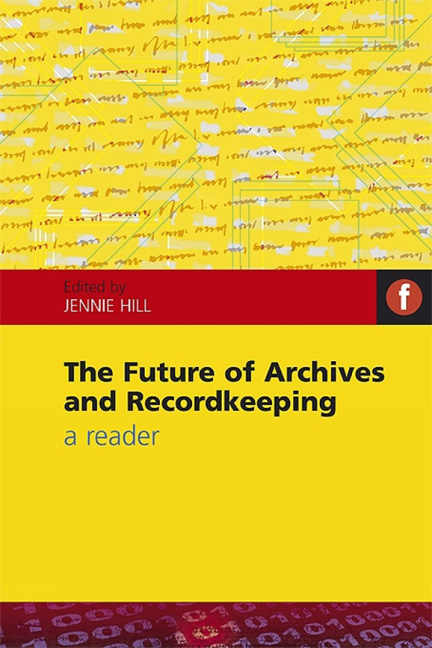Book contents
- Frontmatter
- Dedication
- Contents
- Acknowledgements
- Contributors
- Introduction: seeing the future of archives and recordkeeping
- Part 1 Defining archives
- Part 2 Shaping a discipline
- Part 3 Archive 20: archives in society
- 6 Archons, aliens and angels: power and politics in the archive
- 7 Interactivity, flexibility and transparency: social media and Archives 2.0
- 8 The impact of independent and community archives on professional archival thinking and practice
- Part 4 Archives in the information age: is there still a role for the archivist?
- Index
- Miscellaneous Endmatter
- Miscellaneous Endmatter
- Miscellaneous Endmatter
7 - Interactivity, flexibility and transparency: social media and Archives 2.0
from Part 3 - Archive 20: archives in society
Published online by Cambridge University Press: 08 June 2018
- Frontmatter
- Dedication
- Contents
- Acknowledgements
- Contributors
- Introduction: seeing the future of archives and recordkeeping
- Part 1 Defining archives
- Part 2 Shaping a discipline
- Part 3 Archive 20: archives in society
- 6 Archons, aliens and angels: power and politics in the archive
- 7 Interactivity, flexibility and transparency: social media and Archives 2.0
- 8 The impact of independent and community archives on professional archival thinking and practice
- Part 4 Archives in the information age: is there still a role for the archivist?
- Index
- Miscellaneous Endmatter
- Miscellaneous Endmatter
- Miscellaneous Endmatter
Summary
Introduction
Today it is impossible for most people to imagine the world without the world wide web. This year's ‘Mindset List’, which annually compiles a list designed to reveal the world as the year's college freshmen know it, noted that for these students ‘WWW has never stood for World Wide Wrestling’ (Beloit College, 2009). Although the term ‘internet’ was first applied to the ARPANET (Advanced Research Projects Agency Network) system in 1974, it wasn't until it was opened to ‘commercial interests’ in 1988 that the public began to have access to (text only) services such as e-mail and bulletin boards (Wikipedia, accessed 2009). However, the date 6 August 1991, when Tim Berners-Lee first used hypertext in conjunction with the infrastructure provided by the internet, is generally credited as the birth of the world wide web (Wikipedia, accessed 2009). With the introduction of the first web browser, Mosaic, in 1993, most of the pieces of ‘Web 1.0’ were in place.
Beginnings of the world wide web
Most archives saw the value of using the web to publish information about themselves and their collections – usually in the form of putting finding aids online. In his 1995 article, ‘Archival Outreach on the World Wide Web’, William Landis (1995, 129, 133) reviewed four ‘fairly mature Web sites’, although he noted that an online list contained links to over 600 sites from ‘around the world’. Also appearing in 1995 was David Wallace's ‘Archival Repositories on the World Wide Web: A Preliminary Survey and Analysis’, which reviewed 15 archival websites. Both Landis and Wallace conclude their articles by considering the value the web provided to archives. For Wallace, the value lay in the possibilities presented by ‘data interchange standards’:
Since it is only through such standards that seamless virtual archives will cease to be institution-based and become user-driven. If the promise of hypertext and hypermedia is achieved, users will be able to leap from one site and collection to the next, tracing their unique research, education, and accountability needs across state and national borders without having to punch in a new URL [Uniform Resource Locator] or conduct stop-and-start searching.
(Wallace, 1995, 168)Like Wallace, Landis (1995, 145) envisioned one of the most significant aspects of the web to be the possibility to create ‘a “seamless web” of digital information about repositories and their collections’.
- Type
- Chapter
- Information
- The Future of Archives and RecordkeepingA reader, pp. 127 - 148Publisher: FacetPrint publication year: 2010



